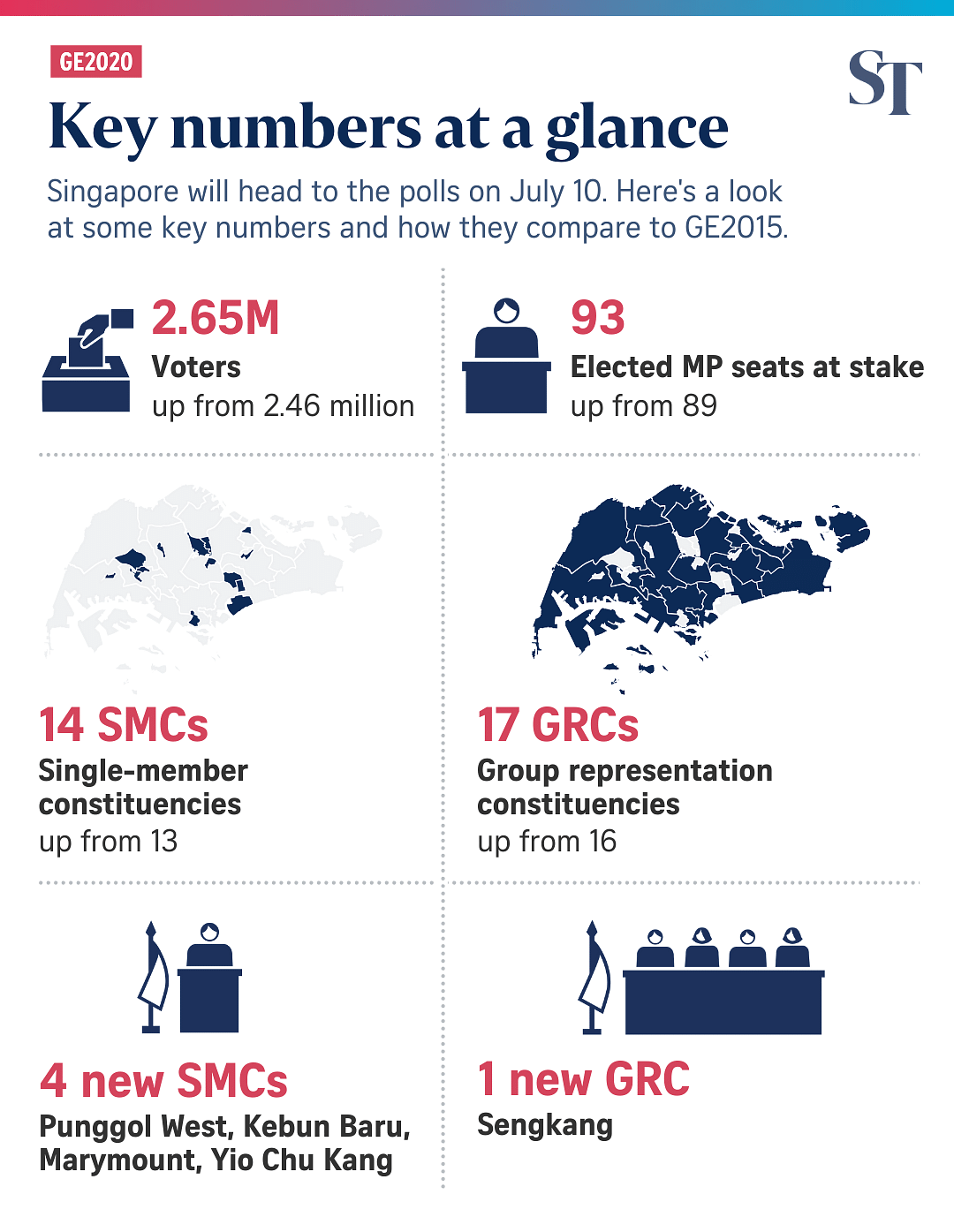SINGAPORE - Singaporeans will go to the polls on July 10, with Nomination Day taking place on June 30. Polling Day will be a public holiday.
This general election, which will take place amid the Covid-19 pandemic, will be unique in Singapore's history due to safe distancing restrictions aimed at curbing the spread of Covid-19.
The Straits Times takes a look at 15 key changes and new measures for the election.
1. MORE MP SEATS AND VOTERS; SMALLER GRCS ON AVERAGE
There will be four more elected MPs in Parliament, with the number of seats increasing from 89 to 93 seats in the upcoming election.
There are 2,653,942 voters heading to the polls, up from 2,460,977 in the 2015 election. The average number of MPs per GRC in the coming election will be 4.65, down from 4.75 in the 2015 election.
Mega six-member group representation constituencies (GRCs) are gone, with Ang Mo Kio and Pasir Ris-Punggol GRCs both trimmed to five-member GRCs.
East Coast GRC and West Coast GRC have each grown from four-member to five-member GRCs.
The maximum number of Non-Constituency MPs will grow from nine to 12. They will be given the same voting rights as elected MPs.
2. NEW CONSTITUENCIES
There will be 14 single-member constituencies (SMCs) and 17 GRCs, up from the current 13 SMCs and 16 GRCs.
There are four new single seats:
-Punggol West, which will be carved out of Pasir Ris-Punggol GRC
-Kebun Baru, formerly part of Nee Soon GRC
- Marymount, previously from Bishan-Toa Payoh GRC
- Yio Chu Kang, which had been part of Ang Mo Kio GRC
Three SMCs have been taken off the map - Punggol East, Sengkang West and Fengshan.
A new four-member Sengkang GRC has been created by merging the former Sengkang West and Punggol East SMCs, as well as parts of Pasir Ris-Punggol GRC.
3. BOUNDARY CHANGES
SMCs
The Joo Seng area of Marine Parade GRC will be in Potong Pasir SMC, while residents of Lorong 8 Toa Payoh will now vote in Bishan-Toa Payoh GRC.
Fengshan residents are now part of East Coast GRC.
Sengkang West's residents find themselves split, with more than half joining the new four-member Sengkang GRC and the rest going to Ang Mo Kio GRC.
All of Punggol East's residents will also vote in Sengkang GRC, as will some in the Buangkok and Sengkang Central areas of Pasir Ris-Punggol GRC.
GRCs
Some residents in Balestier and Novena estates, currently in Bishan-Toa Payoh GRC, will now be under Jalan Besar GRC.
Woodlands residents living near the Woodlands Civic Centre, Singapore Sports School and Woodgrove Primary School, will move from Sembawang GRC to Marsiling-Yew Tee GRC.
Sembawang GRC residents in the Yishun link area on the edge of Yishun New Town will move to Nee Soon GRC.
Some residents in the Nanyang ward of Chua Chu Kang GRC, and some in Hong Kah North SMC adjoining them, will come under West Coast GRC.
4. NEW ARRANGEMENTS FOR ELECTION CANDIDATES
Candidates can fill in most of the required paperwork online, including paying election deposits and preparing nomination papers. However, they still have to submit hard copies of nomination papers in person on Nomination Day.
However, they do not have to be present at the nomination centres if they are unwell or unfit to do so - for instance if they are under quarantine orders or stay-home notices.
Candidates may appoint a representative via a power of attorney to help them file nomination papers and object to other candidates' papers.
Subscribers - including seconders, proposers and assenters - who are unwell will not be allowed to enter the nomination centre. Candidates will need to find someone else to take their place. The formula used to compute a candidate's election deposit has also been simplified. The deposit for the coming election will be $13,500, compared to $14,500 for each candidate in the 2015 election.
5. NO PHYSICAL RALLIES OR MEETINGS; ONLINE CAMPAIGNING ALLOWED
No police permits will be granted for rallies.
Campaigning can be carried out online, and will include activities such as e-rallies.
Internet platforms that e-rallies are streamed on must meet certain requirements - for example, they must have been declared to the Returning Officer.
If they wish, candidates can use venues provided by the Government at subsidised rates to livestream to their declared platforms. However, they must make their own arrangements for filming and livestreaming.
Supporters should not gather at nomination centres on Nomination Day or at assembly centres on Polling Day.
They can follow proceedings on TV or the Internet instead, and should not gather at livestreaming venues.

6. WALKABOUTS AND DOOR-TO-DOOR CAMPAIGNING
Limited to no more than five people in each group, and no mixing between groups is allowed.
Each group should remain at least 1m apart from other groups. They must minimise physical contact, such as shaking hands.
7. CONSTITUENCY POLITICAL BROADCASTS
Parties and candidates will get more airtime on national TV channels, with constituency political broadcasts airing on Mediacorp's Channel 5.
Each SMC candidate gets three minutes for constituency political broadcasts.
GRC candidates get 12 or 15 minutes, depending on the size of the GRC.
This is in addition to the two party political broadcasts on 19 TV/radio channels, up from 13 TV/radio channels in 2015.
Candidates can speak in Singapore's four official languages.
8. USE OF VEHICLES FOR CAMPAIGNING
Candidates can use vehicles - typically lorries or trucks outfitted with loudspeakers - to broadcast recorded messages.
They cannot speak, livestream or broadcast music or videos from the vehicle.
There will be no thank-you vehicular processions after Polling Day.
9. PRECAUTIONS ON NOMINATION DAY
There will be temperature screening at nomination centres, and the SafeEntry system will be used for contact tracing.
Candidates who have a fever or respiratory symptoms will be directed to a separate area, where they can still inspect the nomination papers of other candidates.
10. BEWARE OF FOREIGN INTERFERENCE
Political parties have been told to watch out for foreign interference and cyber security risks during the election.
They should monitor their platforms for suspicious activity and not share posts or tweets of suspicious provenance.
They should also find out how to protect their IT infrastructure and online accounts, as well as the storage and management of their data.
Parties or candidates who detect or suspect foreign interference in elections, or find out that their accounts or systems have been misused or compromised, should make police reports and inform the Elections Department (ELD).
11. STRICTER ONLINE ADVERTISING RULES
Political parties will have to disclose to the ELD where and when paid online advertising will appear in the general election.
Paid online ads must also include statements such as "sponsored by" or "paid for by", indicating that they were paid for by the candidate, political party or an authorised third-party campaigner.
12. CAN THOSE ON STAY-HOME NOTICE VOTE?
Special polling stations will be set up for people on stay-home notices (SHN) at designated facilities like hotels.
For other affected voters, such as those on quarantine orders or serving SHN at home, the ELD said it would consult the Health Ministry when the Writ of Election is issued to assess the public health risks of allowing them to vote.
13. PRECAUTIONARY MEASURES AT POLLING STATIONS
The number of polling stations will be increased from 880 to 1,100. This increase means each station will serve an average of 2,400 voters, down from 3,000.
Voters will be given recommended two-hour time slots to visit polling stations to reduce crowding. Morning slots will be reserved for seniors who are 65 years and older so they can vote before others.
Those who visit the polling stations have to observe safe distancing and wear protective gear such as masks.
There will be temperature screening at the stations to sieve out those with fever or respiratory symptoms. The ELD will decide whether these groups will be allowed to vote based on the prevailing Covid-19 situation during the polls.
Voter registration will be done electronically, with people scanning their identity cards instead of handing them to officials. Voters will have to pull down their masks when election officials have to verify their identity vis-a-vis their NRIC.
14. SAFER AND SMOOTHER PROCESS FOR CASTING VOTES
Before voters can collect their ballot paper, they have to sanitise their hands and put on disposable gloves that will be given to them.
New self-inking pens, which will allow voters to easily stamp an "X" for the party of their choice, will be used. This will help older voters who have difficulty gripping regular pens. Voters will also be allowed to use their own pens if they wish.
Cleaners will be deployed at all polling stations to clean items and areas described as "common touch-points" such as the self-inking pens and polling booths. They will do so at least once every half an hour.
15. SHORTER VOTE-TALLYING PROCESS
Instead of being manually processed, votes will be tallied by counting machines. Counting will be three times faster with the use of the machines.
Polling results, in turn, can be ready about an hour earlier than in past elections.
Correction note: An earlier version of the story did not give the updated number of eligible voters in 2015.


